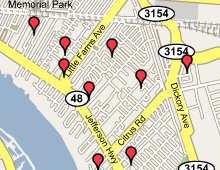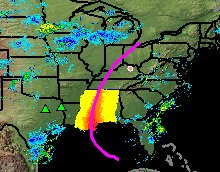This post from Danny Sullivan at Search Engine Watch earlier this week struck a nerve.
"Lycos has a new Search Katrina Missing Persons Sites meta search service now available.In a single search, it checks listings from more than 35 missing person sites that have sprung up since the storm.Sources of these listings are listed in the right-hand navigation.You can also add a site here."
What this suggests is that many well meaning organizations and private citizens established online clearing houses to keep track of missing persons.That, in turn, meant those looking for individuals after the hurricane had to not only locate, but search, 35 or more websites for information.It's pleasing that Lycos, and also Yahoo, are helping to simplify the process.
The raw nerve this announcement struck is the parallel problem we have in the geospatial arena as we try to "discover, find and bind" data that can help in rescue and recovery efforts.Not only are geospatial professionals looking for such data, but so too are thousands of displaced residents of the southeast coast of the United States, their friends and family.Once loved ones are (hopefully) found, and basic needs met, the next question from former residents is often, "What is the status of my house and neighborhood?"
Bright Spots in Geospatial Response
How are we as a nation doing in providing the ability to discover, find and bind geographic data from this unprecedented natural/human disaster? (Discover, find and bind is a phrase picked up from working with Open Geospatial Consortium staff.It means that resources are in fact discoverable, searchable and immediately useable.) The response is mixed, with some bright spots and some holes.
The bright spots include those who have kept an eye on the Web during the last week and teased out the online resources for maps and data downloads.The geospatial press has stepped forward to do that and provided articles and links at regular intervals.The resources they cite include federal, state, local, commercial, hacker and other publications' data, maps and applications.Another set of journalists, from the search engine domain, has also put together such lists.So have "mainstream" journalists, who compile resources for their readers and sometimes, for other journalists.This is laborious work, searching, checking and describing the available content.In some cases, tedious "how to's" must be developed for the applications.
We've been impressed by the speed with which the data vendors are getting the latest imagery out to the broadest possible audience. DigitalGlobe, Space Imaging and ORBIMAGE all seemed to turn on a dime and make imagery of the area a priority.As journalists, we know not to call them in such times, the imagery will appear as soon as it's available.NOAA, NASA, USGS and FEMA (which offers PDFs of images on its website) seemed quite responsive in getting the data collected and making it available on their respective websites.
Another bright spot is the parade of applications and mashups built on Google Maps and the amazing number of overlays for Google Earth, many of which depended on the data noted above.Google worked with DigitalGlobe to provide the latest imagery of the New Orleans area on Google Maps.In the title bar is metadata: "Photos taken on Wednesday, August 31 at 10 am." That information appears when the red "Katrina" button is clicked.
 |
Google did its part with Google Earth, too.
- On Thursday, NOAA imagery was made available on Google Earth.
- On Friday, DigitalGlobe's latest imagery was available.
- On Saturday Google with partners (Carnegie Mellon and NASA) made hundreds of NOAA aerial images available as overlays for Google Earth.
- By Sunday, an overlay was posted that fetched only images of interest, helping manage bandwidth issue related to the large files.
- Tuesday morning, FEMA assessment maps were available.
Holes in Geospatial Response
On the holes side of things, we think it's worth pointing out how little metadata was available with much of the data posted on the Web. We realize time was of the essence in making data available and short cuts were taken in some cases.(This note on a NOAA website is a good example: "Please note that these images are uncorrected and not rotated.") Many sites that noted the NOAA imagery described it as satellite imagery, though it was taken from aircraft.The Google Earth page on Katrina offers minimal descriptions of the source of the imagery or the process that created it.
Geodata.gov did create a channel for Katrina on its old (find it at the bottom of the page under "Learn About Mapping Current Events") and new sites.To date the former contains but 12 sources as this is written on Wednesday.Several of these are CNN, AccuWeather and The Weather Channel.All are basically "links to websites." The new site has more links and descriptions, but essentially points to agency and publication websites.One interesting post from EROS on the Hurricane Tracking/Key Resources/Emergency Resources area: "The USGS Earth Resources Observation and Science Center (EROS) is seeking to obtain information on all remote sensing efforts being conducted in response to Hurricane Katrina in order to provide a centralized reference to these efforts.It would be helpful if anyone conducting remote sensing data collection from any source could pass information on their efforts to ..."
 |
Where should such a "one stop" portal be? At Geodata.gov? At FEMA's website? Who would maintain it? How much time are responders spending wading through all the various sites for data? If such a website does exist for professionals, could we easily bring the data sets, the ones from before and after, the ones from different sensors, the ones from different software packages and different map servers together? We suspect it would be a great deal of work.
What have popped up instead of such resource are a number of one-off apps scattered around the Web such as this one from a hacker and this more commercial one from the Associated Press.
Coordination
The biggest hole and disappointment is the lack of coordination.Why wasn't the city of New Orleans' GIS data immediately available to first responders for rescue efforts? Where was the coordination at the states' geospatial data clearinghouses (if they exist)? Why isn't FEMA or the USGS the coordinator or collector of certain specific geospatial data, or links to data, to support recovery efforts? It is not as if all government agencies were caught off guard on this.The evacuation decree was given on Sunday; the data should have been ready and available in case the unthinkable happened, which it did.
The lack of coordination in rescue and recovery is directly linked to the lack of geospatial data availability and discoverability.Federal coordination is required to disperse much needed map data to federal, state, local and private agencies and organizations at a time of national emergency.This not a side issue; it is one of the major problems facing the recovery efforts in the Gulf region.
The phrase on many lips just now describing the overall government response to Hurricane Katrina is "lack of coordination." We need to consider that very seriously with regard to the geospatial response.